Search Result
Results for "
non-fluorescent
" in MedChemExpress (MCE) Product Catalog:
| Cat. No. |
Product Name |
Target |
Research Areas |
Chemical Structure |
-
- HY-P2267
-
LDV
1 Publications Verification
|
Integrin
|
Others
|
|
LDV, a tripeptide, is a non-fluorescent analog of LDV-FITC. LDV is a α4β1 integrin (VLA-4) ligand, and binds α4β1 integrin in leukemia cells .
|
-

-
- HY-111474
-
|
|
Myosin
|
Cardiovascular Disease
Neurological Disease
|
|
Para-aminoblebbistatin is a highly water soluble, non-fluorescent and photostable C15 amino-substituted derivative of blebbistatin; inhibits various (myosin II) isoforms both in vitro and in vivo.
|
-
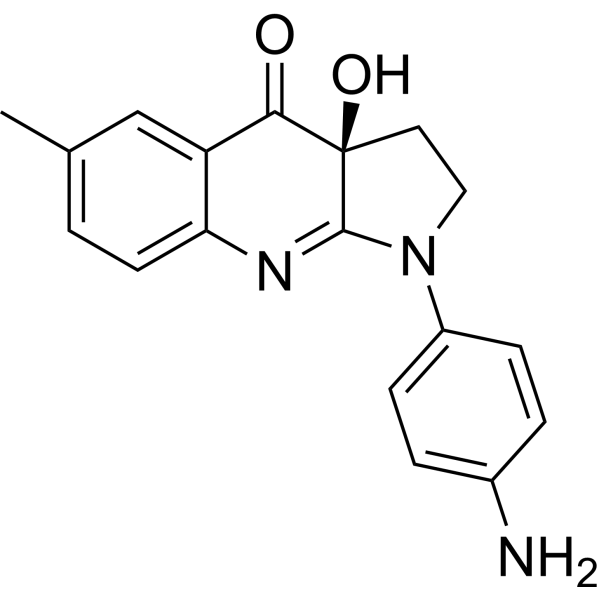
-
- HY-153006
-
|
DCFH2
|
Others
|
Others
|
|
2,7-Dichlorodihydrofluorescein (DCFH2) is a non-fluorescent probe. 2,7-Dichlorodihydrofluorescein yields the highly fluorescent 2′,7′-dichlorofluorescein (DCF) that can be used for reactive oxygen species measurement .
|
-

-
- HY-D1707
-
|
|
Fluorescent Dye
|
Others
|
|
FDGlcU can be used as a fluorescent probe for non-invasively image with a high level of fluorescent activity. FDGlcU is non-fluorescent when the fluorescein is conjugated with two mono-glucuronides (Ex/Em=480/514 nm) .
|
-
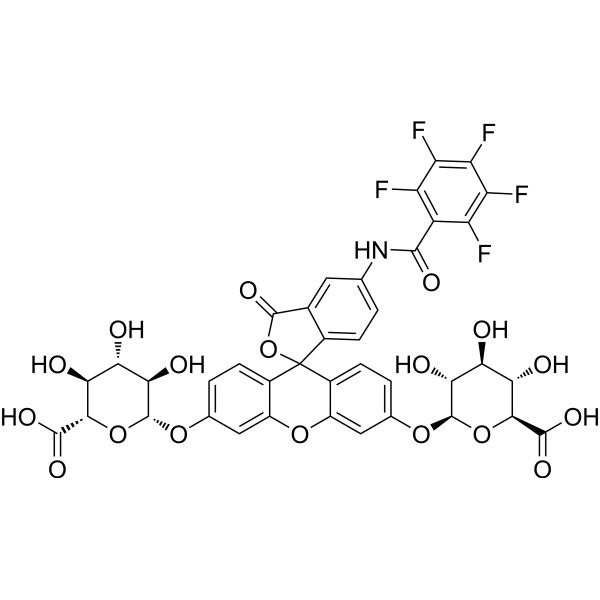
-
- HY-D1699
-
|
|
Fluorescent Dye
|
Others
|
|
PFB-FDG is a non-fluorescent galactosidase substrate that can be hydrolysed to green fluorescent PFB-F (Ex=485 nm, Em=535 nm). PFB-FDG can be used for the determination of β-galactosidase activity .
|
-
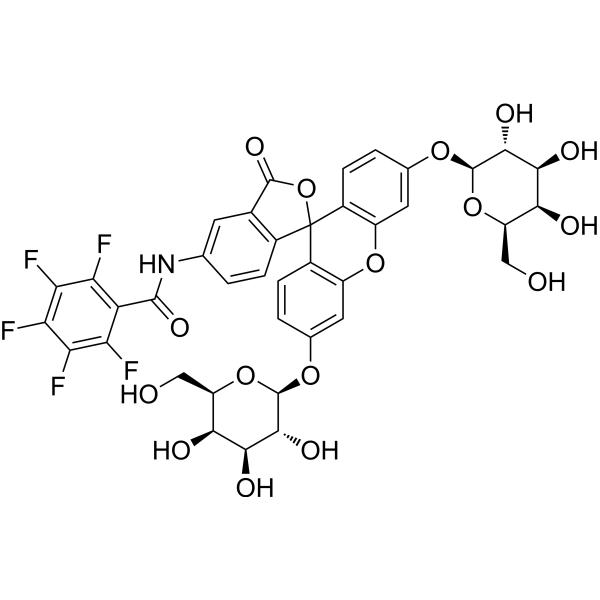
-
- HY-120972
-
|
|
Others
|
Others
|
|
Pentafluorobenzenesulfonyl fluorescein is a H2O2-selective sensor that can be used to detect H2O2 levels in cells. Pentafluorobenzenesulfonyl fluorescein is normally non-fluorescent but fluoresces upon perhydrolysis of the sulfonyl linkage by H2O2 .
|
-

-
- HY-D1682
-
|
|
Fluorescent Dye
|
Others
|
|
NFQ1 is a non-fluorescent quencher (absorption wavelength: 474 nm), and is used for a new type of One Sample Fluorescence Resonance Energy Transfer (OS-FRET) method. OS-FRET enable measurement of unquenched donor emission in the same sample. NFQ1 shows broad absorption spectrum ensuring its utility as a dark acceptor for many donors .
|
-
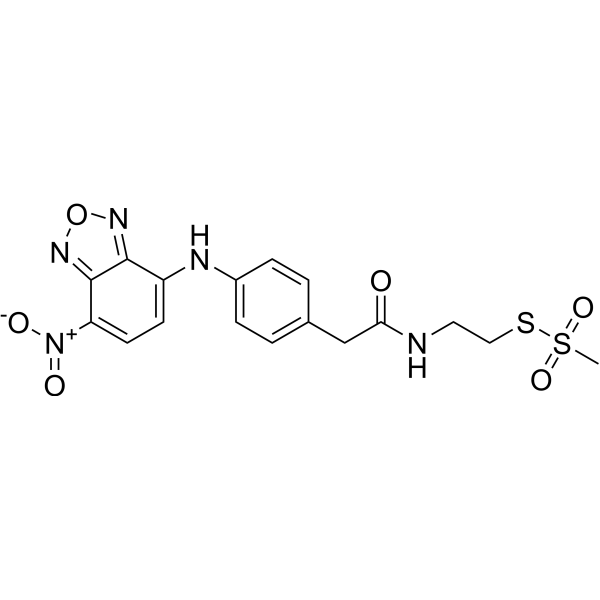
-
- HY-D1687
-
|
|
Fluorescent Dye
|
Others
|
|
Flubi-2 is a fluorescein-biotin based pH-ratio dye (Ex=480 nm, Em= 520-560 nm) with a pK value of 6.7. Flubi-2 is a hydrolysis product of Flubida-2 (non-fluorescent, membrane permeable). Flubi-2 can be used for pH determination of organelles of the secretory pathway (such as golgi apparatus and endoplasmic reticulum) in living cells .
|
-
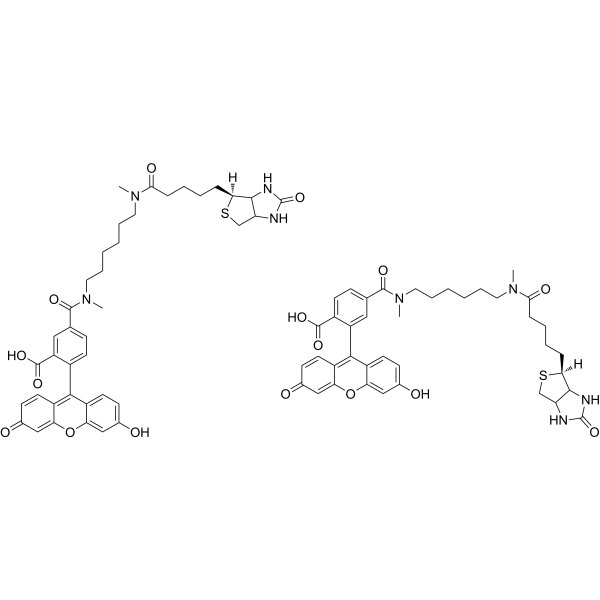
-
- HY-118540
-
|
Diazoresorcinol
|
Fluorescent Dye
|
Others
|
|
Resazurin (Diazoresorcinol) is a water-soluble, non-toxic, stable, membrane-permeable blue non-fluorescent dye (faintly fluorescent). Resazurin is used as a redox indicator, can be reduced to pink, highly fluorescent Resorufin (Ex=530-560 nm, Em=590 nm) in living cells. Resazurin can be used for the detection of cell viability, toxicity, proliferation, migration and invasion in cells (human, plant and animal, bacterial and fungal) .
|
-

-
- HY-D1755
-
|
|
Fluorescent Dye
|
Others
|
|
Fluo-3FF AM is a low affinity (Kd = 42 μM) fluorescent Ca 2+ sensitive indicator (Abs/Em = 462 nm/526 nm). Fluo-3FF AM is Mg 2+ insensitive and relatively photostable. Fluo-3FF AM is an analog of Fluo-3FF AM. Fluo-3FF AM is essentially non-fluorescent, but exhibits a strong fluorescence enhancement upon entry into cells and binding to calcium.
|
-
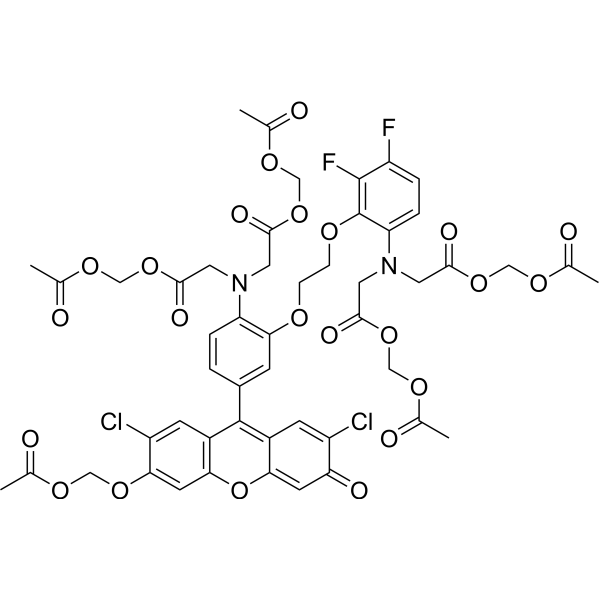
-
- HY-123645
-
|
|
Fluorescent Dye
|
Others
|
|
Rhodamine B hydrazide is a good probe for sulfite, with colorless and non-fluorescent properties. While the emission is related to the concentration of sulfite (5-800 ng/mL; detection limit=1.4 ng/mL (3σ)). Sulfite reduces dissolved oxygen to yield superoxide radicals, which binds to Rhodamine B hydrazide to form Rhodamine B. Rhodamine B hydrazide gives Rhodamine B-like fluorescence in the presence of sulfite, which is enhanced by Tween 80 surfactant micelles. Rhodamine B hydrazide has an absorption maximum at 554 nm and a fluorescence emission maximum at 574 nm .
|
-
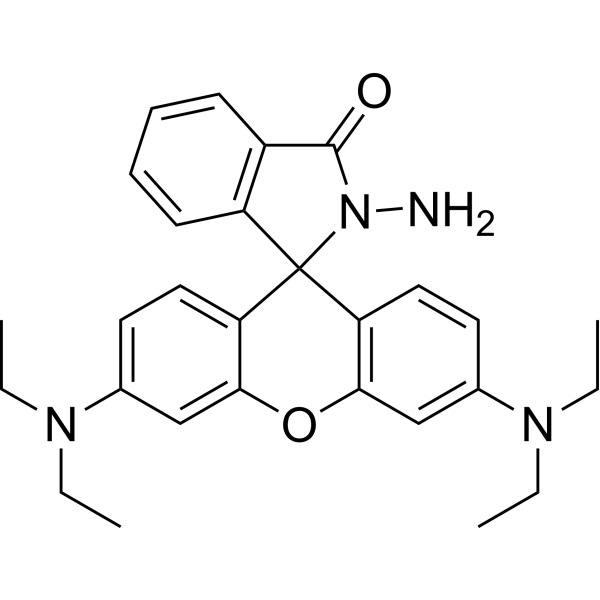
-
- HY-D0918
-
|
|
Fluorescent Dye
|
Others
|
|
YO-PRO-1 (Oxazole yellow) is a carbocyanine monomer and DNA green fluorescent dye that is not permeable to normal animal cell membranes but is permeable to the cell membranes of apoptotic and necrotic cells. YO-PRO-1 is commonly used for the detection of apoptosis and necrosis. YO-PRO-1 has a high affinity for DNA and is essentially non-fluorescent when not bound to DNA. When apoptosis occurs, the permeability of the cell membrane changes. YO-PRO-1 can enter apoptotic cells and bind to DNA and emit bright green fluorescence. Therefore, YO-PRO-1 is often used together with propidium iodide (PI) to analyze and identify apoptotic and necrotic cells.
|
-
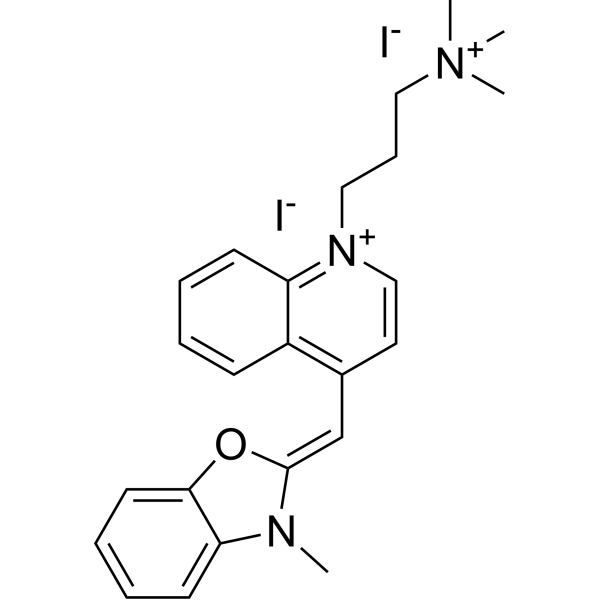
-
- HY-D0042
-
NBD-Cl
1 Publications Verification
NBD chloride
|
Fluorescent Dye
|
Others
|
|
NBD-Cl is a nonfluorescent reagent which becomes highly fluorescent after reaction with thiol or amino groups .
|
-

-
- HY-100041
-
|
Monobromobimane
|
Fluorescent Dye
|
Others
|
|
Bromobimane (Monobromobimane) is a nonfluorescent and converts into fluorescent products when reacts with thiols. Bromobimane has potential applications in labeling thiols .
|
-

-
- HY-133535
-
|
PA-JF646-NHS
|
Fluorescent Dye
|
Others
|
|
PA Janelia Fluor® 646, SE (PA-JF646-NHS), a photoactivatable fluorescent dye, is an NHS ester for coupling to primary amine groups. PA-JF646-NHS is non-fluorescent until activated at 365 nm. NHS ester can be converted to relevant substrate for use in self-labeling tag systems, e.g.HaloTag ® and SNAP-tag ®. PA-JF646-NHS is used for single molecule tracking and super resolution microscopy in live cells, specifically live cell sptPALM and fixed cell PALM. (λExcitation/emission~650/664 nm). Janelia Fluor® products are licensed under U.S. Pat. Nos. 9,933,417, 10,018,624 and 10,161,932 and other patents from Howard Hughes Medical Institute.
|
-
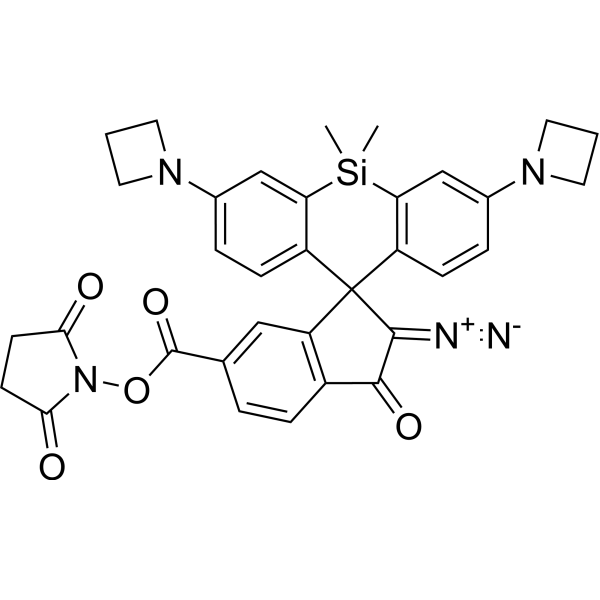
-
- HY-D1045A
-
|
DABCYL sodium; Para-methyl red sodium
|
Fluorescent Dye
|
Others
|
|
Dabcyl acid sodium (DABCYL sodium) is a nonfluorescent chromophore and a quencher. Dabcyl acid sodium can be used as molecular beacon nucleic acid probes to recognize and report the presence of specific nucleic acids in homogeneous solutions .
|
-
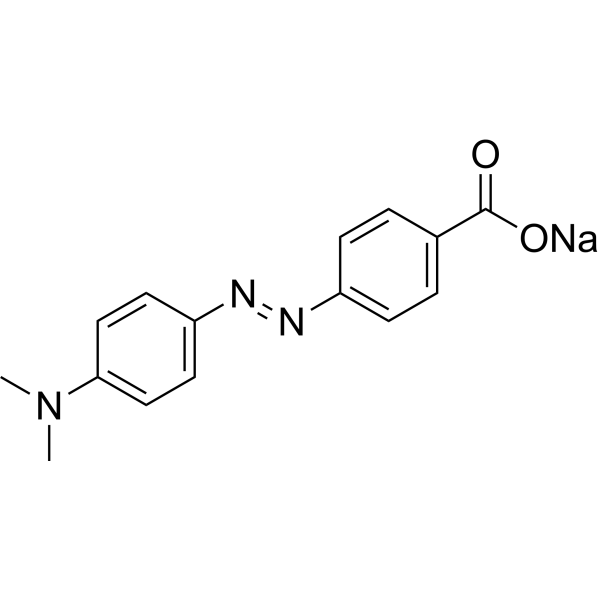
-
- HY-110250
-
DFHBI
Maximum Cited Publications
7 Publications Verification
|
Fluorescent Dye
|
Others
|
|
DFHBI is a small molecule that resembles the chromophore of green fluorescent protein (GFP). Spinach and DFHBI are essentially nonfluorescent when unbound, whereas the Spinach-DFHBI complex is brightly fluorescent both in vitro and in living cells.
|
-
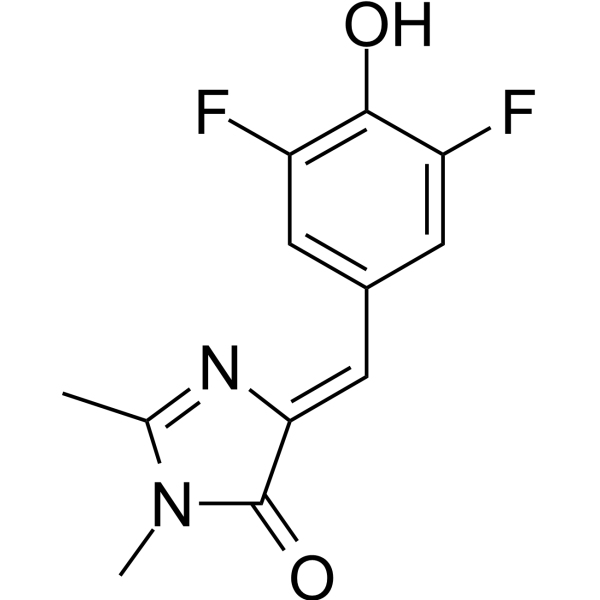
-
- HY-133520
-
|
|
Fluorescent Dye
|
Others
|
|
HBC620 is a HBC analog. HBC is nonfluorescent in solution, but emits strong fluorescence upon forming tight complex with Pepper RNA aptamer. HBC-Pepper complex can be used to visualize RNA dynamics in live cells .
|
-
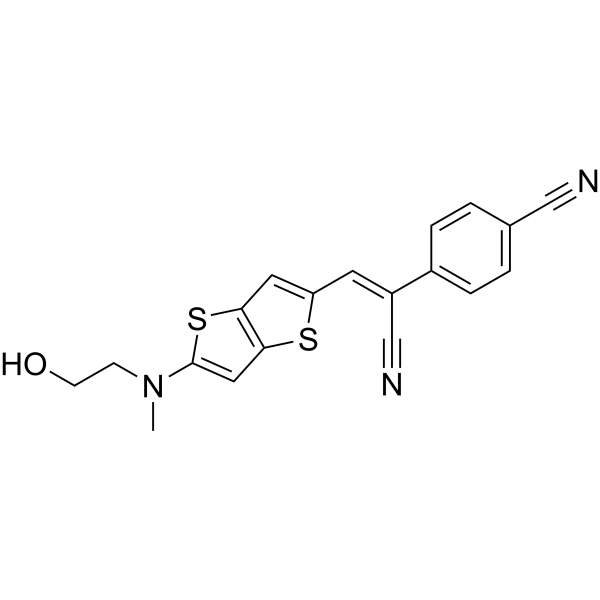
-
- HY-133521
-
|
|
Fluorescent Dye
|
Others
|
|
HBC599 is a HBC analog. HBC is nonfluorescent in solution, but emits strong fluorescence upon forming tight complex with Pepper RNA aptamer. HBC-Pepper complex can be used to visualize RNA dynamics in live cells .
|
-
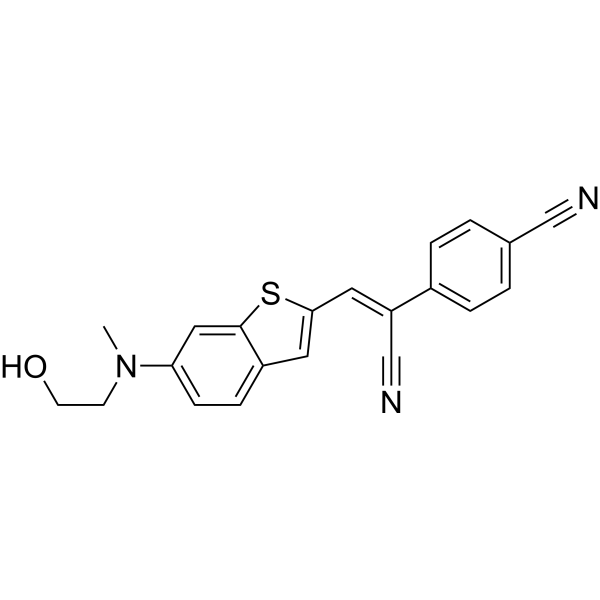
-
- HY-D1416
-
|
|
Fluorescent Dye
|
Others
|
|
HMBR, an analog bearing an additional methyl group on the aromatic ring, is nonfluorescent by itself, but it fluoresces yellow light upon blue-light excitation when bound to Y-FAST. HMBR is nontoxic for zebrafish embryos. cell-permeant .
|
-
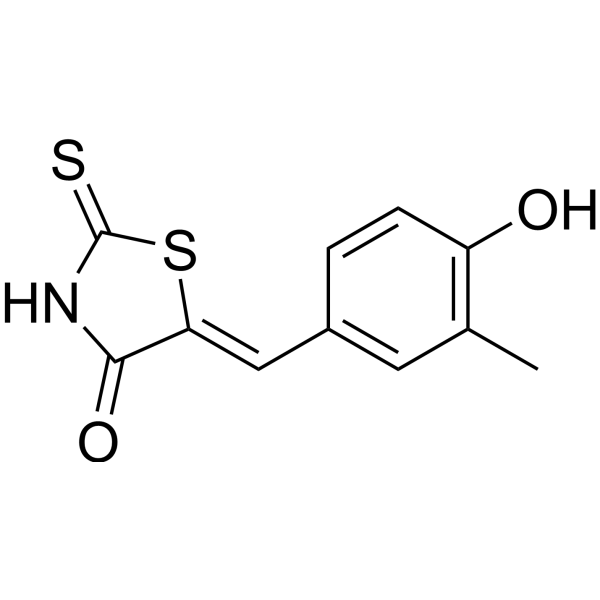
-
- HY-P2496
-
|
|
Endothelin Receptor
|
Cardiovascular Disease
|
|
Endothelin 1 (swine, human), Alexa Fluor 488-labeled is a synthetic Endothelin 1 peptide labled with Alexa Fluor 488. Endothelin 1 (swine, human) is a synthetic peptide with the sequence of human and swine Endothelin 1, which is a potent endogenous vasoconstrictor. Endothelin 1 acts through two types of receptors ETA and ETB .
|
-

-
- HY-133523
-
|
|
Fluorescent Dye
|
Cancer
|
|
HBC514 is a nonfluorescent HBC-analog but emits strong green fluorescence upon forming a tight complex with Pepper RNA aptamer. HBC514-Pepper complex enables visualization of RNAs and the fluorescences can be altered flexibly by simple washing and staining in living Pepper-tagged cells[1].
|
-
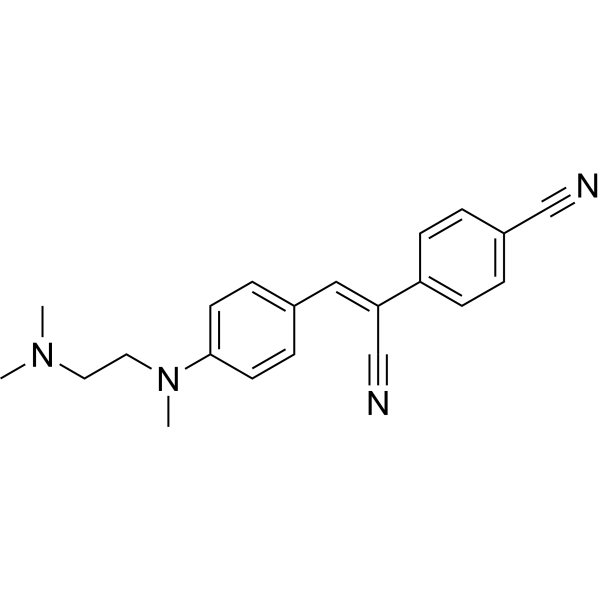
-
- HY-P2089
-
|
|
MMP
|
Others
|
|
Dnp-PYAYWMR is a peptide substrate that selectively targets MMP3. Dnp-PYAYWMR is cleaved by MMP3 to produce Dnp-PYA (nonfluorescent) and YWMR (fluorophore detectable at 360 nm). After incubation of MMP3 with Dnp-PYAYWMR for 2 h, MMP3 fluorescence intensity was measured. Ex/Em=328/350 nm .
|
-
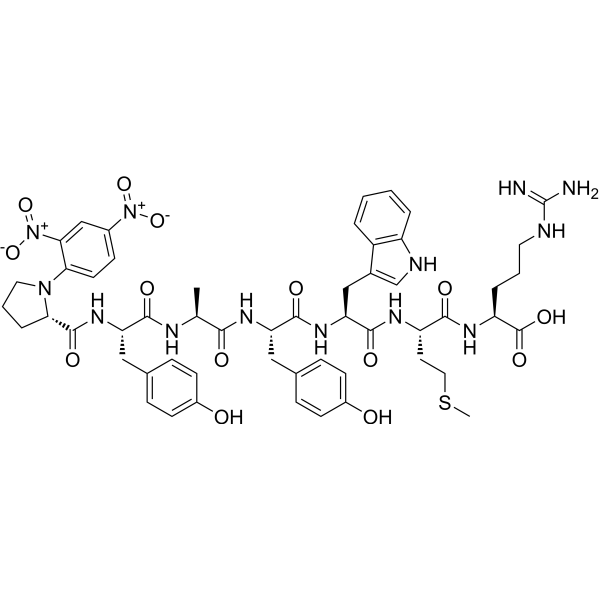
-
- HY-112526
-
|
|
Fluorescent Dye
|
Others
|
|
Thiofluor 623 (Compound 3) is a fluorescent turn-on probe that can be used for the selective sensing and bioimaging of thiols. Thiofluor 623 displays excellent immunity to interference from nitrogen and oxygen nucleophiles. Thiofluor 623 is essentially nonfluorescent in the absence of thiols, which cleave the probe and release the red-emissive donor-acceptor fluorophore (Ex=563 nm, Em=623 nm) .
|
-
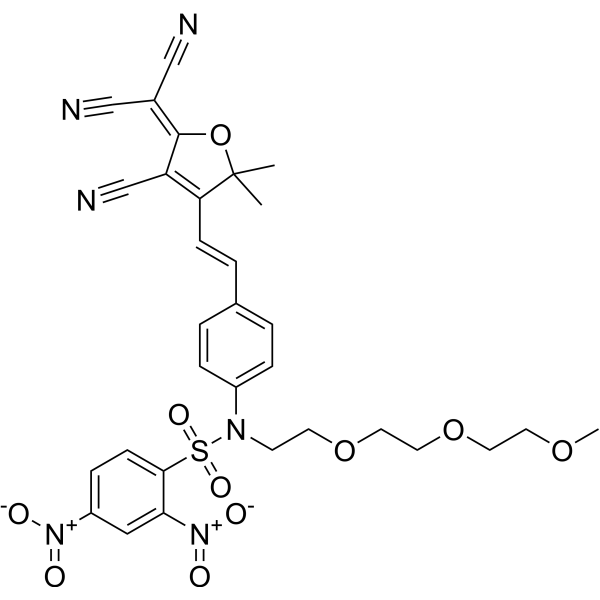
-
- HY-W247098
-
|
DHR 6G
|
Reactive Oxygen Species
|
Cancer
|
|
Dihydrorhodamine 6G (DHR 6G) is the reduced form of Rhodamine 6G, which is used as fluorescent mitochondrial dye. It is nonfluorescent, but it readily enters most of the cells and is oxidized by oxidative species or by cellular redox systems to the fluorescent rhodamine 6G that accumulates in mitochondrial membranes. Dihydrorhodamine 6G is useful for detecting reactive oxygen species (ROS) including superoxide .
|
-
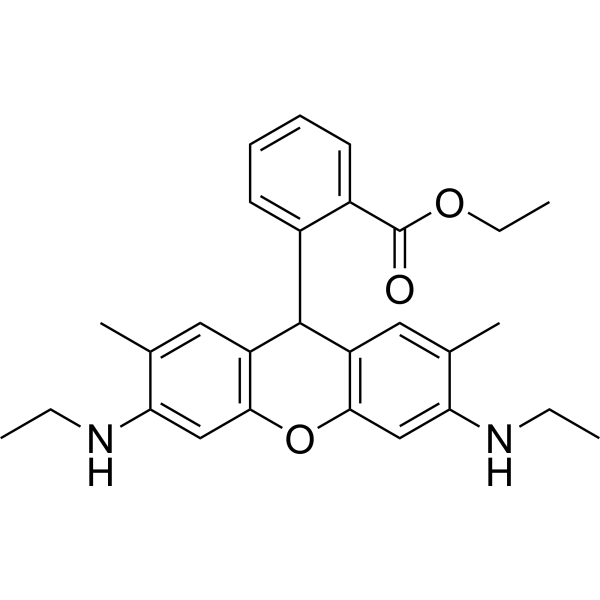
-
- HY-133821
-
|
|
G-quadruplex
|
Neurological Disease
|
|
N-Methylmesoporphyrin IX (NMM), a widely used G-quadruplex DNA specific fluorescent binder, is an efficient probe for monitoring Aβ fibrillation. N-Methylmesoporphyrin IX is an in situ inhibitor and an ex situ monitor for Aβ amyloidogenesis both in vitro and in cells. N-Methylmesoporphyrin IX is sensitive to G-quadruplexes DNA but has no response to duplexes, triplexes and single-stranded forms DNA. N-Methylmesoporphyrin IX is nonfluorescent alone or in monomeric Aβ environments, but emits strong fluorescence through stacking with the Aβ assemblies .
|
-
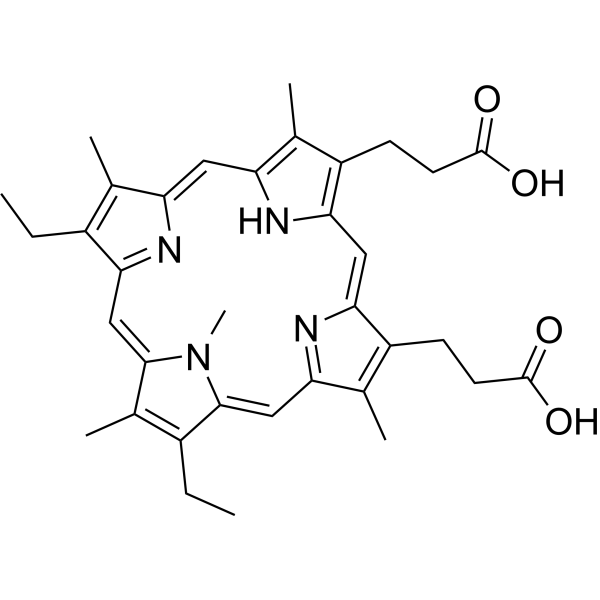
| Cat. No. |
Product Name |
Type |
-
- HY-D1707
-
|
|
Fluorescent Dyes/Probes
|
|
FDGlcU can be used as a fluorescent probe for non-invasively image with a high level of fluorescent activity. FDGlcU is non-fluorescent when the fluorescein is conjugated with two mono-glucuronides (Ex/Em=480/514 nm) .
|
-
- HY-D1699
-
|
|
Fluorescent Dyes/Probes
|
|
PFB-FDG is a non-fluorescent galactosidase substrate that can be hydrolysed to green fluorescent PFB-F (Ex=485 nm, Em=535 nm). PFB-FDG can be used for the determination of β-galactosidase activity .
|
-
- HY-D1682
-
|
|
Fluorescent Dyes/Probes
|
|
NFQ1 is a non-fluorescent quencher (absorption wavelength: 474 nm), and is used for a new type of One Sample Fluorescence Resonance Energy Transfer (OS-FRET) method. OS-FRET enable measurement of unquenched donor emission in the same sample. NFQ1 shows broad absorption spectrum ensuring its utility as a dark acceptor for many donors .
|
-
- HY-D1687
-
|
|
Fluorescent Dyes/Probes
|
|
Flubi-2 is a fluorescein-biotin based pH-ratio dye (Ex=480 nm, Em= 520-560 nm) with a pK value of 6.7. Flubi-2 is a hydrolysis product of Flubida-2 (non-fluorescent, membrane permeable). Flubi-2 can be used for pH determination of organelles of the secretory pathway (such as golgi apparatus and endoplasmic reticulum) in living cells .
|
-
- HY-118540
-
|
Diazoresorcinol
|
Fluorescent Dyes/Probes
|
|
Resazurin (Diazoresorcinol) is a water-soluble, non-toxic, stable, membrane-permeable blue non-fluorescent dye (faintly fluorescent). Resazurin is used as a redox indicator, can be reduced to pink, highly fluorescent Resorufin (Ex=530-560 nm, Em=590 nm) in living cells. Resazurin can be used for the detection of cell viability, toxicity, proliferation, migration and invasion in cells (human, plant and animal, bacterial and fungal) .
|
-
- HY-D1755
-
|
|
Fluorescent Dyes/Probes
|
|
Fluo-3FF AM is a low affinity (Kd = 42 μM) fluorescent Ca 2+ sensitive indicator (Abs/Em = 462 nm/526 nm). Fluo-3FF AM is Mg 2+ insensitive and relatively photostable. Fluo-3FF AM is an analog of Fluo-3FF AM. Fluo-3FF AM is essentially non-fluorescent, but exhibits a strong fluorescence enhancement upon entry into cells and binding to calcium.
|
-
- HY-123645
-
|
|
Fluorescent Dyes/Probes
|
|
Rhodamine B hydrazide is a good probe for sulfite, with colorless and non-fluorescent properties. While the emission is related to the concentration of sulfite (5-800 ng/mL; detection limit=1.4 ng/mL (3σ)). Sulfite reduces dissolved oxygen to yield superoxide radicals, which binds to Rhodamine B hydrazide to form Rhodamine B. Rhodamine B hydrazide gives Rhodamine B-like fluorescence in the presence of sulfite, which is enhanced by Tween 80 surfactant micelles. Rhodamine B hydrazide has an absorption maximum at 554 nm and a fluorescence emission maximum at 574 nm .
|
-
- HY-D0918
-
|
|
Fluorescent Dyes/Probes
|
|
YO-PRO-1 (Oxazole yellow) is a carbocyanine monomer and DNA green fluorescent dye that is not permeable to normal animal cell membranes but is permeable to the cell membranes of apoptotic and necrotic cells. YO-PRO-1 is commonly used for the detection of apoptosis and necrosis. YO-PRO-1 has a high affinity for DNA and is essentially non-fluorescent when not bound to DNA. When apoptosis occurs, the permeability of the cell membrane changes. YO-PRO-1 can enter apoptotic cells and bind to DNA and emit bright green fluorescence. Therefore, YO-PRO-1 is often used together with propidium iodide (PI) to analyze and identify apoptotic and necrotic cells.
|
-
- HY-D0042
-
NBD-Cl
1 Publications Verification
NBD chloride
|
Dyes
|
|
NBD-Cl is a nonfluorescent reagent which becomes highly fluorescent after reaction with thiol or amino groups .
|
-
- HY-100041
-
|
Monobromobimane
|
Fluorescent Dyes/Probes
|
|
Bromobimane (Monobromobimane) is a nonfluorescent and converts into fluorescent products when reacts with thiols. Bromobimane has potential applications in labeling thiols .
|
-
- HY-133535
-
|
PA-JF646-NHS
|
Dyes
|
|
PA Janelia Fluor® 646, SE (PA-JF646-NHS), a photoactivatable fluorescent dye, is an NHS ester for coupling to primary amine groups. PA-JF646-NHS is non-fluorescent until activated at 365 nm. NHS ester can be converted to relevant substrate for use in self-labeling tag systems, e.g.HaloTag ® and SNAP-tag ®. PA-JF646-NHS is used for single molecule tracking and super resolution microscopy in live cells, specifically live cell sptPALM and fixed cell PALM. (λExcitation/emission~650/664 nm). Janelia Fluor® products are licensed under U.S. Pat. Nos. 9,933,417, 10,018,624 and 10,161,932 and other patents from Howard Hughes Medical Institute.
|
-
- HY-D1045A
-
|
DABCYL sodium; Para-methyl red sodium
|
Fluorescent Dyes/Probes
|
|
Dabcyl acid sodium (DABCYL sodium) is a nonfluorescent chromophore and a quencher. Dabcyl acid sodium can be used as molecular beacon nucleic acid probes to recognize and report the presence of specific nucleic acids in homogeneous solutions .
|
-
- HY-110250
-
DFHBI
Maximum Cited Publications
7 Publications Verification
|
Fluorescent Dyes/Probes
|
|
DFHBI is a small molecule that resembles the chromophore of green fluorescent protein (GFP). Spinach and DFHBI are essentially nonfluorescent when unbound, whereas the Spinach-DFHBI complex is brightly fluorescent both in vitro and in living cells.
|
-
- HY-133520
-
|
|
Fluorescent Dyes/Probes
|
|
HBC620 is a HBC analog. HBC is nonfluorescent in solution, but emits strong fluorescence upon forming tight complex with Pepper RNA aptamer. HBC-Pepper complex can be used to visualize RNA dynamics in live cells .
|
-
- HY-133521
-
|
|
Dyes
|
|
HBC599 is a HBC analog. HBC is nonfluorescent in solution, but emits strong fluorescence upon forming tight complex with Pepper RNA aptamer. HBC-Pepper complex can be used to visualize RNA dynamics in live cells .
|
-
- HY-D1416
-
|
|
Fluorescent Dyes/Probes
|
|
HMBR, an analog bearing an additional methyl group on the aromatic ring, is nonfluorescent by itself, but it fluoresces yellow light upon blue-light excitation when bound to Y-FAST. HMBR is nontoxic for zebrafish embryos. cell-permeant .
|
-
- HY-133523
-
|
|
DNA Stain
|
|
HBC514 is a nonfluorescent HBC-analog but emits strong green fluorescence upon forming a tight complex with Pepper RNA aptamer. HBC514-Pepper complex enables visualization of RNAs and the fluorescences can be altered flexibly by simple washing and staining in living Pepper-tagged cells[1].
|
-
- HY-112526
-
|
|
Fluorescent Dyes/Probes
|
|
Thiofluor 623 (Compound 3) is a fluorescent turn-on probe that can be used for the selective sensing and bioimaging of thiols. Thiofluor 623 displays excellent immunity to interference from nitrogen and oxygen nucleophiles. Thiofluor 623 is essentially nonfluorescent in the absence of thiols, which cleave the probe and release the red-emissive donor-acceptor fluorophore (Ex=563 nm, Em=623 nm) .
|
-
- HY-133821
-
|
|
Fluorescent Dyes/Probes
|
|
N-Methylmesoporphyrin IX (NMM), a widely used G-quadruplex DNA specific fluorescent binder, is an efficient probe for monitoring Aβ fibrillation. N-Methylmesoporphyrin IX is an in situ inhibitor and an ex situ monitor for Aβ amyloidogenesis both in vitro and in cells. N-Methylmesoporphyrin IX is sensitive to G-quadruplexes DNA but has no response to duplexes, triplexes and single-stranded forms DNA. N-Methylmesoporphyrin IX is nonfluorescent alone or in monomeric Aβ environments, but emits strong fluorescence through stacking with the Aβ assemblies .
|
| Cat. No. |
Product Name |
Target |
Research Area |
-
- HY-P2267
-
LDV
1 Publications Verification
|
Integrin
|
Others
|
|
LDV, a tripeptide, is a non-fluorescent analog of LDV-FITC. LDV is a α4β1 integrin (VLA-4) ligand, and binds α4β1 integrin in leukemia cells .
|
-
- HY-P2496
-
|
|
Endothelin Receptor
|
Cardiovascular Disease
|
|
Endothelin 1 (swine, human), Alexa Fluor 488-labeled is a synthetic Endothelin 1 peptide labled with Alexa Fluor 488. Endothelin 1 (swine, human) is a synthetic peptide with the sequence of human and swine Endothelin 1, which is a potent endogenous vasoconstrictor. Endothelin 1 acts through two types of receptors ETA and ETB .
|
-
- HY-P2089
-
|
|
MMP
|
Others
|
|
Dnp-PYAYWMR is a peptide substrate that selectively targets MMP3. Dnp-PYAYWMR is cleaved by MMP3 to produce Dnp-PYA (nonfluorescent) and YWMR (fluorophore detectable at 360 nm). After incubation of MMP3 with Dnp-PYAYWMR for 2 h, MMP3 fluorescence intensity was measured. Ex/Em=328/350 nm .
|
Your information is safe with us. * Required Fields.
Inquiry Information
- Product Name:
- Cat. No.:
- Quantity:
- MCE Japan Authorized Agent:


































